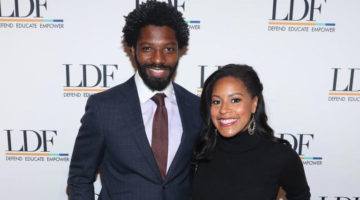Left photo: South Florida residents enjoyed the advanced screening of “Whose Streets,” a documentary that tells the story of the movement in Ferguson, Missouri after the shooting death of Mike Brown Jr. from those who lived through it, held Aug. 10 at O Cinema in Wynwood. Center photo: Activist Brittany Farrell and her six-year-old daughter are shown protesting. Right photo: 103.5 The Beat radio personalities Stichiz and Papa Keith spoke to the audience at the advanced screening of “Whose Streets.”
By ISHEKA N. HARRISON
iharrison@sfltimes.com
MIAMI – An intimate crowd gathered at O Cinema Wynwood last Thursday, Aug. 10, to view an advanced screening of “Whose Streets,” a noholds-barred account of the movement that took place in Ferguson, Missouri in 2014 after Michael Brown Jr. – an unarmed black 18-year-old who was heading to college in a few days – was shot to death by 28-year-old Darren Wilson, a white police officer.
But if you think you already know this story from all of the news coverage you’ve seen, you probably really have no idea. The emotional documentary shows the story from the point of view of the Ferguson residents who lived through the aftermath of Brown’s death, their fight against injustice and demand for equality.
Admittedly hard to watch, the film uses the call and response liberation chant, “Whose streets? Our streets!” and shows lots of footage that mainstream media omitted while covering the riots and looting that ensued after Brown was killed.
Compelling scenes reveal the fires, looting and angry faces of residents that received widespread coverage. Protesters visible anger was likely their response to major aggression from police, who are shown on original footage and cell phone video threatening and bombing peaceful protestors with tear gas, shooting them with rubber bullets from armored military vehicles and forcing them into their homes far ahead of curfew.
Directed by Sabaah Folayan and Damon Davis, the film invokes quotes from pivotal moments and influential people throughout history; and displays tweets from many of the activists and residents who were living through it.
Those prominently highlighted in the documentary include: activist Brittany Farrell, a mother of a six-year-old girl that marries another female activist, Alexis Templeton.
Farrell puts nursing school on hold to focus on the movement; Tef Poe, a local rapper and activist who rallies his community to take a stance against injustice because they still have to live there once the masses are gone; David Whitt, a husband and father who takes to the streets with his video camera to ‘CopWatch’ in an effort to keep his community safe and Brown’s legacy alive; Kayla Reed, Tory Russell and several others.
In the midst of utter chaos and mistreatment, some protestors get understandably fed up with being peaceful. But another aspect the mainstream media didn’t show was their fellow citizens calming them down and telling them to resist that urge so they would be there to fight another day.
One of the most heartwrenching moments in the film occurs when it is announced that Wilson would not be indicted and Brown’s mother, Lezley McSpadden, breaks down crying. Not surprisingly, things also get very charged between protestors and police in that moment – and chaos ensues.
Tragically, the film also reveals that several front-runners of the movement are dead today. They include: Darren Seals, an outspoken activist who was found shot to death in a burning car Sept. 6, 2016; and Edward Crawford, a father of four who was captured in an iconic picture throwing a tear gas canister back at the police. His death earlier this year was ruled a suicide, but his father said he doesn’t believe Crawford would have taken his own life.
Seals and Crawford were 29 and 27-years-old respectively. (NOTE: At least six black men have been found in a similar manner to Seals in the area since the protests.)
As I said, “Whose Streets” is tough to watch, but it is also necessary. It tells the story that so many others have not. The powerful resilience of blacks in Ferguson through the extreme conditions they’ve endured, and continue to fight, is on full display.
It is a display that more than intimate crowds at advanced screenings like the one held last Thursday should see. Theatres should be packed and all who have a true heart for humanity should fill the seats.
But I’d be remiss if I didn’t tell you to prepare your mind because you might leave angry. But – in the wake of continued audacious racism like that displayed in Charlottesville, Virginia this past weekend – if that anger propels you to action, then Folayan and Davis have done their job.
In the words of the Ferguson activists from the film: “It is our duty to fight for our freedom! It is our duty to win! We must love and support each other! We have nothing to lose but our chains!”













No Comment